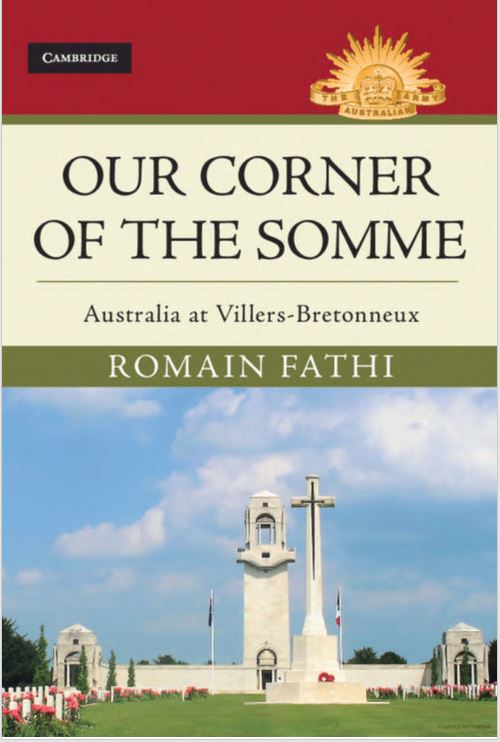This is a doctoral work that examines every aspect of the ‘Australian – French connection’ that is Villers-Bretonneux’.
Commencing with Germany’s Operation Michael (4-5 April 1918), the German diversion and Allied counterattack (24-25 April) both at Villers-Bretonneux, and the Battle of Amiens (8 – 11 Aug 1918) and examining the composition of the Allied forces involved, the massive discrepancy between fact and mythology is laid bare.

Hardback 270pp RRP: $59.95
In Australia’s case, a victory was sorely needed to boost recruiting after the defeat of the second conscription referendum of December 1917, so the propaganda machine had swung into action, especially when it came to the role played by Anzacs in France. Other combatants involved were conveniently overlooked even when they played a far greater role. Australia ‘saved Villers-Bretonneux, defended Amiens, and played a huge part in the victory on the Western Front. The reality was that Australia had one corps of five divisions (that fought in the British IV Army), on the Western Front, Canada had one corps, and France had a total of 104 divisions on the entire Western Front. Most French were aware that British dominions fought in Europe and few today have even heard of Villers-Bretonneux.
Perhaps the best-known feature of Villers-Bretonneux is the Victoria School – a gift not wanted at the time by the locals desperate for an entity that would go towards restoring employment. It came with strings attached and was also to be seen as a memorial to the Victorian Education Department’s commitment to the war effort. Targeting children with Australia’s version of history that omitted the defendants of all other countries was the most effective way of ensuring Australian’s deeds would be kept alive and their graves would be tended. Victoria’s total gift to the community comprised only three percent of the monies used in Villers-Bretonneux’s post-war restoration! ‘The Australian enterprise of self-aggrandisement, promoted at institutional levels . . . reveals a need for external praise and validation to strengthen the emerging national tradition.’ (page 64).
In August 1938 the Australian National Memorial was opened at Villers-Bretonneux with 30 000 troops (actually 2000) lining the road, a guard of honour of at least 1500 promised (400) and 100 000 French (2000) to visit after the opening being typical of the exaggeration and overstatement of importance of the event. From the Memorial’s unveiling until the late 1980s Villers-Bretonneux faded from Australia’s commemorative agenda, apart from Anzac Day ceremonies that commenced in 1951. A French-Australian museum was opened in the attic of the Victoria School on Anzac Day 1975. The twinning of Villers-Bretonneux with Robinvale (NW Victoria) occurred in 1984.
Prime Ministers Bob Hawke and John Howard were instrumental in pushing Anzac ‘values’ as part of the nation’s history and there was resurgence in Australians’ visits to Anzac Cove and the Western Front. In 1993 the Unknown Soldier was exhumed at Villers-Bretonneux, and his reburial at the Australian War Memorial’s Hall of Memory became a national commemoration. Prime Minister Keating denied Australia’s ‘Britishness’ – implying it was now an independent nation (ready to become a republic). As the level of Australian government representation at Villers-Bretonneux ceremonies rose, so has the level of French government officials attending them.
From the 1980s the Department of Veterans’ Affairs (DVA) has worked tirelessly in the promotion of the Anzacs (in all conflicts) in Australia’s collective memory. The French have become more involved as they see the economic benefits of the tourists (rather than pilgrims) to the north east of France. In 2008 Australia took over the running of the Villers-Bretonneux Anzac Dawn Service and it has become entrenched as one of the three televised Anzac services in Australia. The opening on Anzac eve 2018 of the Sir John Monash Centre marked the centrepiece of the DVA Anzac Remembrance Trail project. Historical accuracy was not the intention of the Centre: described by one commentator as not being for scholars, but for entertainment. ‘Since 1918 the Australian government and its representatives have delivered speeches and erected plaques, monuments and memorials that have gone beyond the commemoration of the dead and have underpinned a proud national narrative’ (page 199).
Commensurate with other volumes in this series, the presentation is immaculate, with photographs, maps, graphs, appendices, 32 pages of notes, a 21-page bibliography and index. Fathi’s readable style makes this an appealing examination of our corner of the Somme.
Reviewed for RUSIV by Neville Taylor, February 2019
Contact Royal United Services Institute about this article.






